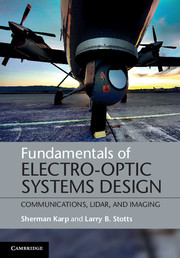Book contents
- Frontmatter
- Contents
- Preface
- Notation
- 1 Genesis of electro-optic systems
- 2 Role of electromagnetic theory in electro-optics systems
- 3 Photo-detection of electromagnetic radiation
- 4 Metrics for evaluating photo-detected radiation
- 5 Contrast, visibility and imaging
- 6 Signal modulation schemes in optical communications
- 7 Forward error correction coding
- 8 Modern communications designs for FOC/FSOC applications
- 9 Light detection and ranging
- 10 Communications in the turbulence channel
- 11 Communications in the optical scatter channel
- Appendix A Two-dimensional Poisson processes
- Appendix B Propagation of finite beams in water
- Appendix C Non-Lambertian scattering
- Appendix D Communications noise sources besides signal/background shot noise
- Index
- References
8 - Modern communications designs for FOC/FSOC applications
Published online by Cambridge University Press: 05 February 2013
- Frontmatter
- Contents
- Preface
- Notation
- 1 Genesis of electro-optic systems
- 2 Role of electromagnetic theory in electro-optics systems
- 3 Photo-detection of electromagnetic radiation
- 4 Metrics for evaluating photo-detected radiation
- 5 Contrast, visibility and imaging
- 6 Signal modulation schemes in optical communications
- 7 Forward error correction coding
- 8 Modern communications designs for FOC/FSOC applications
- 9 Light detection and ranging
- 10 Communications in the turbulence channel
- 11 Communications in the optical scatter channel
- Appendix A Two-dimensional Poisson processes
- Appendix B Propagation of finite beams in water
- Appendix C Non-Lambertian scattering
- Appendix D Communications noise sources besides signal/background shot noise
- Index
- References
Summary
Introduction
This chapter discusses some of the key aspects of the signal modulation and coding schemes used in FOC and FSOC systems today. Most notably, we will review the use of return-to-zero (RZ) and non-return-to-zero (NRZ) in coding the information streams and see their effect on systems performance, as well as receiver sensitivity.
Modern signal modulation schemes
Let us begin with some definitions.
Return-to-zero (RZ)
RZ describes a signal modulation technique where the signal drops (returns) to zero between each incoming pulse. The signal is said to be “self-clocking”. This means that a separate clock signal does not need to be sent alongside the information signal to synchronize the data stream. The penalty is the system uses twice the bandwidth to achieve the same data-rate as compared to non-return-to-zero format (see next definition).
Although any RZ scheme contains a provision for synchronization, it still has a DC component, resulting in “baseline wander” during long strings of “0” or “1” bits, just like the line code non-return-to-zero. This wander is also known as a “DC droop”, resulting from the AC coupling of such signals
Information
- Type
- Chapter
- Information
- Fundamentals of Electro-Optic Systems DesignCommunications, Lidar, and Imaging, pp. 141 - 150Publisher: Cambridge University PressPrint publication year: 2012
